Exeter Astrophysics STFC DiRAC Research
STFC's
DiRAC programme has provided support for the Astrophysics Group's
high performance computing (HPC) research since 2009. DiRAC-1 provided
funding for HPC access on
Exeter's supercomputer from 2009-2012.
During DiRAC-2, we have been allocated time on
DiRAC's Complexity machine.
Our science programmes are listed below.
Interstellar medium evolution and molcular cloud formation (Dobbs/Acreman)

We are performing simulations of galaxies, and sections of galaxies, to
investigate molecular cloud evolution and star formation. We aim to
understand the role of feedback, magnetic fields and spiral structure in
determining the properties of molecular clouds and galactic star
formation rates. These simulations also allow us to estimate the
lifetimes and star formation efficiencies of molecular clouds, which are
very difficult to determine observationally. We are also performing
radiative transfer calculations to produce CO maps from our
hydrodynamical simulations and compare with maps of the Milky Way.
As well as determining how well the simulations reproduce the Galactic
molecular gas structure as seen in CO, we can also compare maps resulting
from simulations of different galaxy models to identify which spiral
arm and bar patterns best represent the large scale structure of our Galaxy.
More information.
Star cluster formation (Bate)
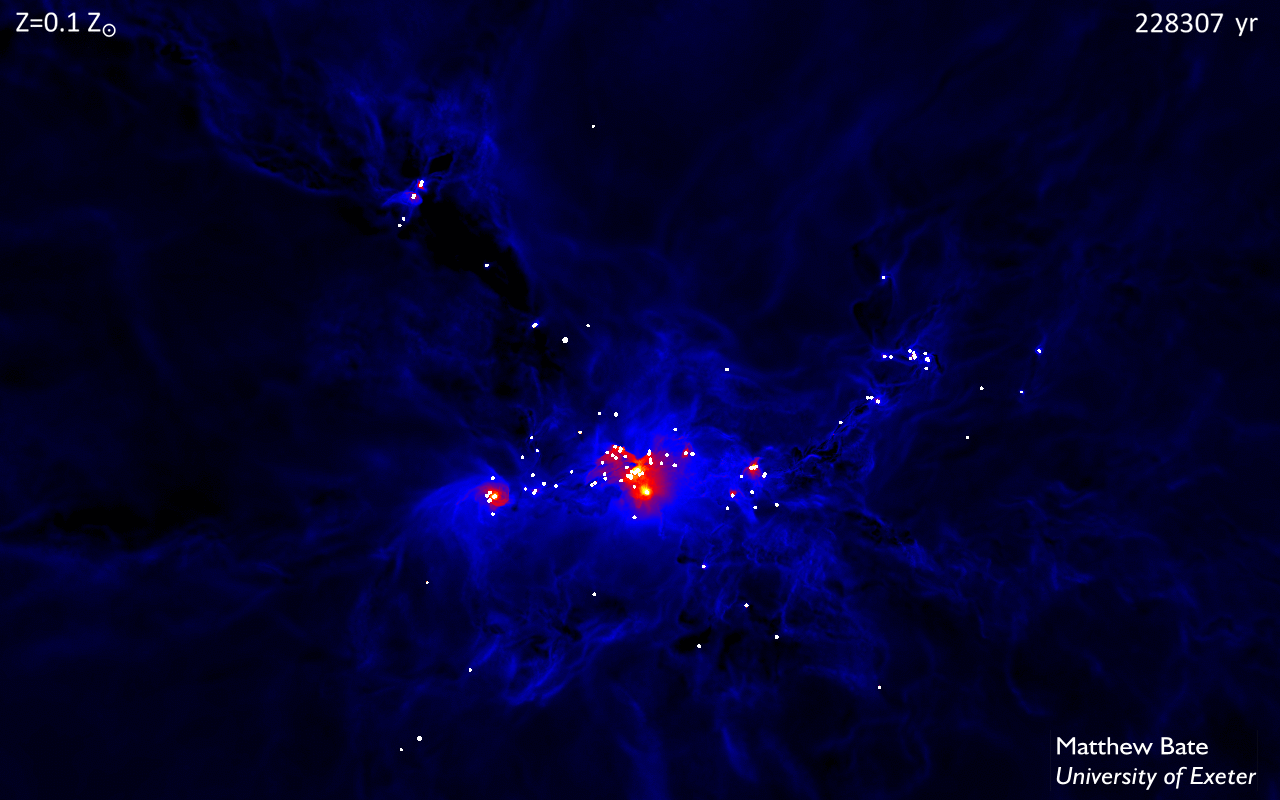
We are performing radiation (magneto-)hydrodynamical simulations of star
formation in order to understand the origins of stellar properties and how
stellar properties may vary in different environments. We wish to determine
what sets the distribution of stellar masses and the rate and efficiency
of star formation, what sets the fractions of
stars that are single, binary, or in higher-order systems, the properties
of multiple systems (e.g. their separations and mass ratios), and the
diversity of protoplanetary discs found around young stars.
More information.
Massive star formation and feedback (Harries/Acreman)
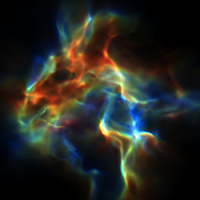
Radiation hydrodynamical simulations of massive star formation.
More information.
Solar and stellar convection and magnetism (Browning)
 More information.
More information.
Multi-dimensional implicit stellar evolution (Baraffe)
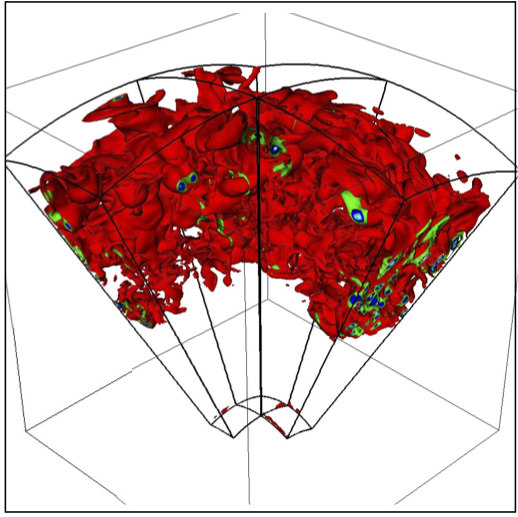
We are developing a three-dimensional time-implicit fully-compressible
hydrodynamical code, that allows the multi-dimensional description of a
complete star (or planet) interior during timescales relevant to the
study of various stellar/planetary evolutionary phases. The objective
is to achieve a performant and accurate numerical tool which (i)
describes processes characterised by timescales much longer than the
hydrodynamical timescale, (ii) handles flows characterised by extreme low
(M < 10
−8) to moderate (M ≈ 1) Mach numbers and (iii) describes
the wide range of spatial scales prevailing in stellar interiors. The
development of such a tool is extremely challenging and innovative,
as it has not been developed to date. The major scientific motivation
is to improve the description of key stellar/planetary physics processes
and to solve long standing problems characterising the life of stars
and planets. The first astrophysical applications are devoted to
(i) the early phases of evolution of low mass stars and brown dwarfs,
characterised by accretion process, (ii) stellar rotation and the
study of angular momentum transport and chemical mixing in stars and
(iii) the study of turbulent convection in stars and planets.
More information.
Planet formation (Bate)
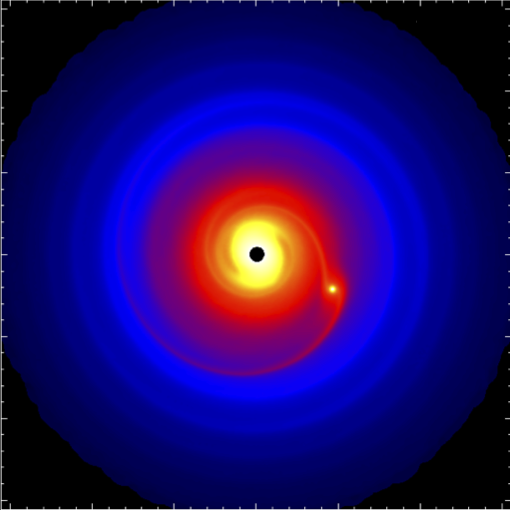
We are studying the formation of gas giant planets, like Jupiter and Saturn, in
the discs of gas and dust surrounding young stars. We are performing
self-gravitating radiation hydrodynamical models to study the structure of
young planets, the formation of discs around the protoplanets, and the
radial migration of protoplanets in their discs. We are also developing
new methods for modelling dusty gas so that we can simultaneously model
how both the gas and dust distributions are affected by the presence of
a protoplanet. This will allow us to make more realistic predictions
of what protoplanets may look like using telescopes like
ALMA and
ELTs.
More information.
Exoplanet atmospheres (Baraffe/Mayne/Acreman)
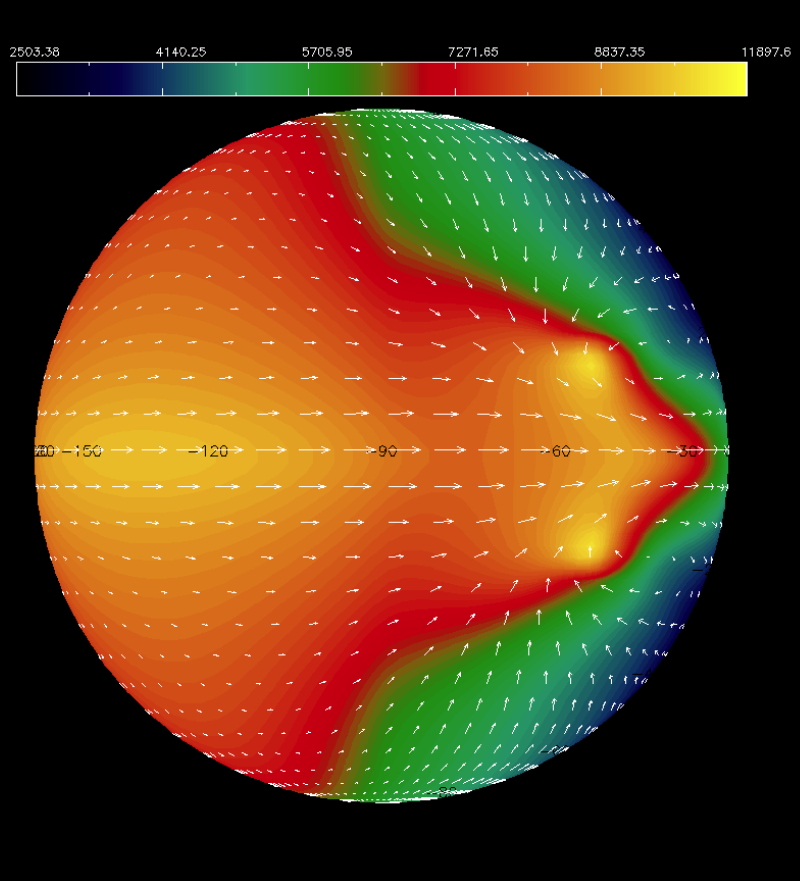
We are developing a planetary simulator based on the UK Met Office general
circulation model (GCM) which is called the UM (or Unified Model). This
`simulator' will actually comprise a hierarchical set of tools available
across a range of sophistications and applicable as stand-alone, or
coupled models. Using this set of tools we aim to interpret observations of
exoplanets and Solar system planets, and understand the dominant driving
mechanisms of the large-scale, long-term climates of planets. Initially,
we are adapting the UM to study `hot Jupiters', giant exoplanets in close
orbits, as they have the most constraining observations outside our own
Solar system, and require demandingly extreme adaptations. This work
aims to answer why such hot Jupiters appear much larger than interior
models predict, what causes the apparent correlation of redistribution of
heat from the day to night side with the irradiation felt by the planet, and
how do the detected aerosols affect their atmospheres.
More information.
 We are performing simulations of galaxies, and sections of galaxies, to
investigate molecular cloud evolution and star formation. We aim to
understand the role of feedback, magnetic fields and spiral structure in
determining the properties of molecular clouds and galactic star
formation rates. These simulations also allow us to estimate the
lifetimes and star formation efficiencies of molecular clouds, which are
very difficult to determine observationally. We are also performing
radiative transfer calculations to produce CO maps from our
hydrodynamical simulations and compare with maps of the Milky Way.
As well as determining how well the simulations reproduce the Galactic
molecular gas structure as seen in CO, we can also compare maps resulting
from simulations of different galaxy models to identify which spiral
arm and bar patterns best represent the large scale structure of our Galaxy.
More information.
We are performing simulations of galaxies, and sections of galaxies, to
investigate molecular cloud evolution and star formation. We aim to
understand the role of feedback, magnetic fields and spiral structure in
determining the properties of molecular clouds and galactic star
formation rates. These simulations also allow us to estimate the
lifetimes and star formation efficiencies of molecular clouds, which are
very difficult to determine observationally. We are also performing
radiative transfer calculations to produce CO maps from our
hydrodynamical simulations and compare with maps of the Milky Way.
As well as determining how well the simulations reproduce the Galactic
molecular gas structure as seen in CO, we can also compare maps resulting
from simulations of different galaxy models to identify which spiral
arm and bar patterns best represent the large scale structure of our Galaxy.
More information.
 We are performing radiation (magneto-)hydrodynamical simulations of star
formation in order to understand the origins of stellar properties and how
stellar properties may vary in different environments. We wish to determine
what sets the distribution of stellar masses and the rate and efficiency
of star formation, what sets the fractions of
stars that are single, binary, or in higher-order systems, the properties
of multiple systems (e.g. their separations and mass ratios), and the
diversity of protoplanetary discs found around young stars.
More information.
We are performing radiation (magneto-)hydrodynamical simulations of star
formation in order to understand the origins of stellar properties and how
stellar properties may vary in different environments. We wish to determine
what sets the distribution of stellar masses and the rate and efficiency
of star formation, what sets the fractions of
stars that are single, binary, or in higher-order systems, the properties
of multiple systems (e.g. their separations and mass ratios), and the
diversity of protoplanetary discs found around young stars.
More information.
 Radiation hydrodynamical simulations of massive star formation.
More information.
Radiation hydrodynamical simulations of massive star formation.
More information.
 More information.
More information.
 We are developing a three-dimensional time-implicit fully-compressible
hydrodynamical code, that allows the multi-dimensional description of a
complete star (or planet) interior during timescales relevant to the
study of various stellar/planetary evolutionary phases. The objective
is to achieve a performant and accurate numerical tool which (i)
describes processes characterised by timescales much longer than the
hydrodynamical timescale, (ii) handles flows characterised by extreme low
(M < 10−8) to moderate (M ≈ 1) Mach numbers and (iii) describes
the wide range of spatial scales prevailing in stellar interiors. The
development of such a tool is extremely challenging and innovative,
as it has not been developed to date. The major scientific motivation
is to improve the description of key stellar/planetary physics processes
and to solve long standing problems characterising the life of stars
and planets. The first astrophysical applications are devoted to
(i) the early phases of evolution of low mass stars and brown dwarfs,
characterised by accretion process, (ii) stellar rotation and the
study of angular momentum transport and chemical mixing in stars and
(iii) the study of turbulent convection in stars and planets.
More information.
We are developing a three-dimensional time-implicit fully-compressible
hydrodynamical code, that allows the multi-dimensional description of a
complete star (or planet) interior during timescales relevant to the
study of various stellar/planetary evolutionary phases. The objective
is to achieve a performant and accurate numerical tool which (i)
describes processes characterised by timescales much longer than the
hydrodynamical timescale, (ii) handles flows characterised by extreme low
(M < 10−8) to moderate (M ≈ 1) Mach numbers and (iii) describes
the wide range of spatial scales prevailing in stellar interiors. The
development of such a tool is extremely challenging and innovative,
as it has not been developed to date. The major scientific motivation
is to improve the description of key stellar/planetary physics processes
and to solve long standing problems characterising the life of stars
and planets. The first astrophysical applications are devoted to
(i) the early phases of evolution of low mass stars and brown dwarfs,
characterised by accretion process, (ii) stellar rotation and the
study of angular momentum transport and chemical mixing in stars and
(iii) the study of turbulent convection in stars and planets.
More information.
 We are studying the formation of gas giant planets, like Jupiter and Saturn, in
the discs of gas and dust surrounding young stars. We are performing
self-gravitating radiation hydrodynamical models to study the structure of
young planets, the formation of discs around the protoplanets, and the
radial migration of protoplanets in their discs. We are also developing
new methods for modelling dusty gas so that we can simultaneously model
how both the gas and dust distributions are affected by the presence of
a protoplanet. This will allow us to make more realistic predictions
of what protoplanets may look like using telescopes like ALMA and ELTs.
More information.
We are studying the formation of gas giant planets, like Jupiter and Saturn, in
the discs of gas and dust surrounding young stars. We are performing
self-gravitating radiation hydrodynamical models to study the structure of
young planets, the formation of discs around the protoplanets, and the
radial migration of protoplanets in their discs. We are also developing
new methods for modelling dusty gas so that we can simultaneously model
how both the gas and dust distributions are affected by the presence of
a protoplanet. This will allow us to make more realistic predictions
of what protoplanets may look like using telescopes like ALMA and ELTs.
More information.
 We are developing a planetary simulator based on the UK Met Office general
circulation model (GCM) which is called the UM (or Unified Model). This
`simulator' will actually comprise a hierarchical set of tools available
across a range of sophistications and applicable as stand-alone, or
coupled models. Using this set of tools we aim to interpret observations of
exoplanets and Solar system planets, and understand the dominant driving
mechanisms of the large-scale, long-term climates of planets. Initially,
we are adapting the UM to study `hot Jupiters', giant exoplanets in close
orbits, as they have the most constraining observations outside our own
Solar system, and require demandingly extreme adaptations. This work
aims to answer why such hot Jupiters appear much larger than interior
models predict, what causes the apparent correlation of redistribution of
heat from the day to night side with the irradiation felt by the planet, and
how do the detected aerosols affect their atmospheres.
More information.
We are developing a planetary simulator based on the UK Met Office general
circulation model (GCM) which is called the UM (or Unified Model). This
`simulator' will actually comprise a hierarchical set of tools available
across a range of sophistications and applicable as stand-alone, or
coupled models. Using this set of tools we aim to interpret observations of
exoplanets and Solar system planets, and understand the dominant driving
mechanisms of the large-scale, long-term climates of planets. Initially,
we are adapting the UM to study `hot Jupiters', giant exoplanets in close
orbits, as they have the most constraining observations outside our own
Solar system, and require demandingly extreme adaptations. This work
aims to answer why such hot Jupiters appear much larger than interior
models predict, what causes the apparent correlation of redistribution of
heat from the day to night side with the irradiation felt by the planet, and
how do the detected aerosols affect their atmospheres.
More information.
